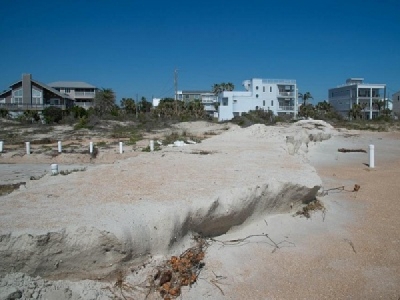
Posted on March 13, 2018
By Jake Martin, The St. Augustine Record
The nor’easter and the big waves that came with it last weekend renewed concerns over erosion of St. Johns County’s beaches, which have been impacted by two hurricanes and a slew of other intense storms the past couple of years.
Residents in Porpoise Point said the tide came up to or breached their bulkheads. The ocean came all the way up to the seawall at the St. Johns County Pier in St. Augustine Beach. Waves washed back into the Summer Haven River, where a multi-million dollar effort to rebuild dunes and restore the river continues.
For many, the combination of high tide and stormy conditions stoked fears it won’t take much to decimate what’s left of the beaches or do further damage to properties.
Commission Chair Henry Dean on Tuesday called the latest bad weather a “significant storm event.”
He said although it was really the “tail end or a spinoff” of the major damage done in the Northeast, the county still took “some serious damage” and in anticipation of that, staff was proactive in addressing some key access points around Vilano Beach.
Dean thanked county staff and the Florida Inland Navigation District for coordinating an effort to put dozens of dump trucks worth of sand on Porpoise Point ahead of the storm to avoid what would have been “some substantial flooding.”
County Attorney Patrick McCormack said the county and FIND entered into an interlocal agreement to enable the county to access the district’s sand (at no cost to the county) for emergency use. He said the administration informed Dean of the county’s intent ahead of time.
Commissioners retroactively approved the interlocal agreement with a unanimous vote.
Neal Shinkre, public works director for the county, told The Record on Friday shoring up Porpoise Point was something they acted upon because they were already seeing 4-6 foot waves and the area is already having drainage issues that were exacerbated by hurricanes Matthew and Irma.
“The whole area is eroded,” he said, adding there’s a kind of “vortex effect” near the jetty that is allowing ocean water to come into Porpoise Point and get into roads, infrastructure and homes. He said some of this erosion is on federal property.
Shinkre said the emergency sand “really worked for us.”
“The damage was very minimal to none,” he said. “Should we not have done that, it would have been different.”
Elsewhere in the county, he said calls came in about erosion but there were no “drastic impacts,” although there was a “small breach” at Summer Haven River.
“It’s not permanent,” Shinkre said. “At low tide you can kind of walk through it, but at high tide it’s connected.”
He said the county is working with a variety of agencies including the Federal Emergency Management Agency to see what can be done, specifically in response to Hurricane Matthew. He said there are a couple of projects for Summer Haven for which a feasibility study is nearing completion, but he said those conversations have been more about infrastructure than sand.
“That area obviously continues to experience erosion and washouts from the river and the ocean,” he said. “It’s reached a point now that everything there has been eroded and just the profile of that area makes it so vulnerable.”
Shinkre said he did not hear of any significant impacts to U.S. Army Corps of Engineers’ renourishment project underway at St. Augustine Beach.
“The project will be completed in the next few months,” he said. “I’ve not heard anything bad so far.”
Shinkre said calls that came in before and after the nor’easter were mostly general concerns about erosion.
“When nor’easters come they call and ask what we’re doing about it and we get back into educating what the county is working on,” he said. “But there’s no immediate signs of relief on that besides our sand placement projects.”
The county continues to work with residents north of the St. Augustine Inlet on securing a one-time dune and berm restoration project for South Ponte Vedra and Vilano Beach while discussing what a long-term plan for protecting the north beaches could look like.
There are a lot of things up in the air just for the short-term fix, particularly in determining who should shoulder the burden of paying the local share. The county is looking to provide the largest, most effective project it can within a proposed $24 million budget, which would include about $10.5 million from the Florida Department of Environmental Protection requiring a 50-50 match.
Commissioners in February directed staff to survey property owners of the roughly 389 oceanfront parcels in the current Municipal Service Taxing Unit, which was created to recoup the costs over time from benefiting property owners, and which has been revised numerous times over the past few months. Adding a fifth cent to the bed tax to go toward beach management is also on the table, but would require a yes vote by at least four of five commissioners.
Shinkre said he expects surveys will go out by March 21, after the next commission meeting, which will include an update on where the county’s efforts stand and what options are available going forward. Those surveys would likely be due back to the county 60 days later.
The current project area stretches from about 2539 S. Ponte Vedra Blvd. to 3244 Coastal Highway, encompassing about 7.5 of beach where an estimated 900,000 cubic yards of sand was lost.
Look for more in the The Record next week on the sand plan for South Ponte Vedra and Vilano Beach.
Source: The St. Augustine Record





